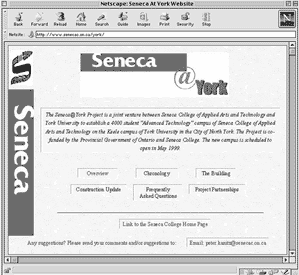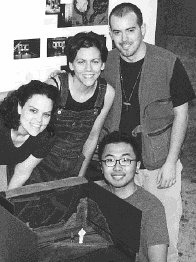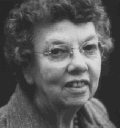 |  |
| | |
| | VOLUME 29, NUMBER 34 | WEDNESDAY, JUNE 23, 1999 | ISSN 1199-5246 | | |
| | ||
|
|
By Susan Scott 'York's Centre for the Study of Computers in Education (CSCE) has partnered with The Learning Company (TLC), a US software firm, to create an endowed student award in technology leadership, a preview centre for student teachers, new software and an international technology summit. This is the first time TLC has formed a partnership in Canada. Beginning this academic year, TLC will establish a preview centre in the University's Faculty of Education. At the preview centre, student teachers, faculty, and alumni will have access to software product lines offered by companies such as TLC, Compton's, MECC, Skills Bank, Creative Wonders, Mindscape and Broderbund. They will be able to see how the software works, check out the manuals, and even check out the software itself for use in practical teaching sessions, or at home. The donation of educational software is worth approximately $25,000. "This donation will provide a significant boost to students in the Faculty of Education by giving them access to the top product software line from The Learning Company," says Ron Owston, director of the CSCE at York. "Not only will they have access to it in the faculty preview centre, but they will be able to use the software in schools where they are doing their practice teaching, and at home. No other company has provided our students with that level of access." TLC will also donate $5,000 which will be matched by the Ontario government and endowed to provide an annual $500 bursary to a full-time York University education student who demonstrates leadership skills in using technology in the classroom. The recipient of The Learning Company Canada Technology Leadership Award will present a workshop or seminar on how they've used technology in an educational or community setting. "This award points the way to the ever-increasing role that technology will play in the classroom. Students and faculty at York University will be in a great position to influence the way that technology supports educational goals in the next century. And it demonstrates TLC's commitment to staying at the forefront of professional development and pre-service teacher training," says Robert Martellacci, Canada regional sales manager for TLC's School Division. TLC and York will team up in several joint ventures including an international technology summit, planned for next year, and a structured in-service and training program in technology will be jointly developed with the Faculty of Education, in addition to a pilot project for integrating software training into Faculty curriculum. The CSCE was established in 1987 as a research unit within York's Faculty of Education. It is Canada's first, and one of the few, formal university-based centres focusing on research related to the teaching uses of computers. The Learning Company, based in New York, is one of the leading developers of education, reference, personal productivity and family entertainment software in the US.
| |
|
|
By Cathy Carlyle Jennifer Jimenez, Bridget Steis, Ted Rouse and Ken Chan stand with the exhibit sent to Prague Quadrennial '99. Professors and students from the York Department of Theatre are all set to face the spotlight this June in Prague, Czech Republic. Not for them the world of understudies awaiting their chance to be recognized. They are to travel with their displays to "Prague Quadrennial '99", the major World Exhibition of Stage Design and Theatre Architecture which takes place every four years. The goal of the event is to bring together stage designers from all over the world, giving them a chance to exhibit their work. Countries feature their work in several categories, including national, professional, schools, and architecture sections. An added bonus is that exhibitors could share their experiences with colleagues. Phillip Silver, dean of the Faculty of Fine Arts, is serving as the Commissioner-General of the Canadian Exhibit. The designs in that exhibit have been chosen from "Stage Design in Canada 1994-1998", which he curated last year at Gallery Stratford. Silver is an award-winning set, lighting and costume designer for theatre and opera in his own right. His own model is on display in Prague from the 1996 Stratford Festival for the production of "The Merchant of Venice". York was among several universities and colleges in the schools section of the exhibition. Third and fourth-year theatre design students, Geoff Bouckley, Ken Chan, Angela Gendron, Diane Hogg, Jen Jansen, Jennifer Jimenez, Ted Rouse and Bridget Steis submitted entries; most of their exhibits being course work completed within the last two years. Professor John Mayberry, assisted by fourth-year student Nicole Williamson, and in consultation with other design production faculty in the Department of Theatre, considered their work high calibre and chose to show it at the event. Jimenez, Williamson, and fellow students Anna-Marie Braet and Sarah Dalgleish had their own role to play at Prague Quadrennial '99, assisting faculty members at this year's exhibition. They also had opportunities to attend an exciting round of lectures, seminars and other events. This was not the first international exposure for Jimenez. Last summer, she was among the York theatre students participating in the prestigious International Student Theatre Festival in Berlin, Germany. Aside from Jimenez, the other students who had displays at the event were unable to attend. "We thought of the program as a great opportunity for students from around the world to have their work on display. It also gives those who can actually attend a chance to meet and talk with internationally-renowned theatre production professionals," said Mayberry, Co-curator of the Canadian Student Exhibit, which included designs by students from seven universities across Canada. York was the only Ontario university represented. As the Canadian technical commissioner for the International Organization of Scenographers, Theatre Architects and Technicians (OISTAT), Mayberry is one of three international theatre technicians to lead a session, "PQ99 from a Technician's Perspective". When students tour the exhibition after hearing the presentation, they have an opportunity to look at the designs with a technical eye. Professor Peter McKinnon, York Chair of the Department of Theatre, attends the exhibition as executive committee member of OISTAT. He organized the OISTAT Side Program of events, which was a series of lectures and demonstrations by some of the world's leading practitioners in theatrical design and realization.
| |
|
|
By Nishat Karim Vanier College and Residence: He was a lawyer, a soldier, a diplomat and an ambassador. But it was his personality that created such a remarkable impression on anyone who met him. Vanier was a man with unshakable courage, inner serenity, honesty and a genuine sense of humour. He was a man who believed in helping people at anytime. General George P. Vanier officially opened York University's Keele campus in 1965 as the Governor General of Canada. Vanier College and Residence were built in 1965, and named in his honour in 1966. The college and residence could not have chosen a better man to represent them - a man who can inspire us all not only to be successful in our careers, but also in our minds and hearts.
| |
|
|
By Cathy Carlyle Tom McElroy holds the CPFM instrument next to the pod into which it was placed. The instrument measured gases in the atmosphere. A paper by York researchers Tom McElroy, Jack McConnell and Chris McLinden, "Evidence for bromine monoxide in the free troposphere during the Arctic sunrise", published in the January 1999 edition of Nature magazine, is adapted here. It is rare for scientists to find an answer quickly, or even a definitive answer to a direct question. What usually happens is that, after painstaking work, they get small clues that shrink the bigger puzzle, that give them signposts to find their way out of a maze. This is so in the research undertaken by Professors Tom McElroy, Jack McConnell and Chris McLinden. They knew that there were dramatic ozone losses occurring in the Arctic polar springtime, not just in the stratosphere - the layer of atmosphere around earth that stretches up to 50 kms into space - but also in the troposphere, which varies from a height above the earth of 18 kms over the equator to only eight kms over the poles. This phenomena was noted in the late 1980s, according to McElroy, professor of physics and astronomy at York, and research scientist with the Air Quality Research Branch, Atmosphere and Environment Service (AES) of Environment Canada. "There are periods of hours or days when the ozone disappears as the sun returns to the Arctic polar regions and by May the phenomenon is over. During that time, scientists observed high levels of bromine monoxide (BrO) in the planetary boundary layer [PBL], so we suspected there was a correlation between the two gases." One of the mysteries was the significance of this possible correlation. What does it mean to science and to our planet? Are humans, alone, to blame for the ozone drop-off? McElroy and McConnell, a York professor in earth and atmospheric science, and PhD student McLinden were reluctant to draw any conclusions from the evidence. "The connection with the amount of BrO found and the depletion of the surface ozone layer is tenuous," said McConnell. "However, ultimately there is a web of information that represents our understanding of nature that has been garnered, and this is part of that web." McElroy pointed out that the fall-off in the amount of PBL ozone is largely a natural occurrence. Ozone is formed in the stratosphere mainly over the tropics and is distributed by stratospheric winds around the world. Small amounts of this gas escape from the stratosphere to the troposphere where it is present near the earth's surface too, along with ozone produced locally there. In the winter polar night, ozone over the Arctic ice remains relatively constant as there is no sunlight to split ozone molecules. The ozone is only slowly destroyed on the surface of the ice. Then, as spring arrives, the sun appears to initiate the destruction of ozone and, as McElroy says, something causes it to disappear totally but sporadically. The amount of ozone in that region remains low throughout the summer. Most of the public is aware that people have introduced excessive amounts of chlorine (from chlorofluorocarbons - commonly called CFCs) and other ozone-destroying chemicals, such as halons, which contain chlorine and bromine, into the stratosphere. These substances are not destructive until they rise through the troposphere above the ozone layer in the stratosphere, and are broken down by intense ultraviolet radiation into other more chemically-active forms of chlorine. What is even worse is that these active chemicals are not removed as a result of the reaction, but roam freely to continue destroying ozone in the stratosphere. In addition, the polar stratosphere temperature sinks as low as minus 80 degrees Celsius in winter, causing certain "polar stratospheric clouds" to form, composed of ice, nitric acid and sulphuric acid. These clouds cause chlorine and bromine to become less stable in the stratosphere. When sunlight arrives in spring the compounds are split apart, releasing chlorine and bromine which then attack ozone and give rise to the ozone hole. For McElroy, McConnell and McLinden, one of the puzzles in the process was how BrO reached the free troposphere from the PBL. They already knew about the presence of BrO from observations taken from NASA's ER-2 aircraft. Theory suggested that BrO emanated from sea salt that accumulated on the Arctic snow pack. It exists much higher up year-round in the stratosphere, as well. But how does it get from its ground-based origin many kilometres past the powerful PBL which often is only a few hundred metres high, as far as three to five kilometres up into the free troposphere? "We weren't, in the beginning, actively trying to find BrO in the atmosphere," said McElroy. "We first hooked up with NASA in 1992 when they wanted us to measure the absolute intensity of light. They had thought that they could adequately calculate light levels necessary for their chemical models, but caution dictated that there should be measurements. "At the time, we were working on an apparatus to send up with the space shuttle, an instrument to record the distribution of gases - nitrogen dioxide, ozone, aerosols - in the atmosphere. A visitor [to Environment Canada's Air Quality Research Branch] from NASA saw our spectrometer - the composition and photodissociative flux measurement (CPFM) instrument, which was in the form of a small box designed and constructed on the premises at AES. It is small enough to fit into a [one-metre] pod on the aircraft wing. There can be no excess weight on the ER-2 aircraft, and the NASA visitor saw that the small pod wouldn't create a problem on the wing." McLinden explained that, "One of the fringe benefits of this whole process is that we have confirmed that instruments like the CPFM, which can be mounted on conventional aircraft, too, should prove very useful in probing the atmosphere below." During the April 1997 ER-2 flight about 19 kms into the stratosphere, the CPFM indicated the presence of BrO in the troposphere. It was able to do this by observing its effect on sunlight reflecting on the Arctic ice below. The scientists were surprised at the large amount of BrO present and they began to question how it arrived in that layer high above the surface of the earth but below the plane and the stratosphere. "Our data showed to us that the large areas of ice leads [cracks] in the Arctic, caused mainly by the motion of currents, could be the source of the BrO," said McElroy. "Where the cracks are, the water is just above freezing, though the ice nearby can be as cold as minus 40 or minus 50 degrees Celsius. The Arctic ice is where we find BrO. "Because of this enormous contrast in temperatures, a powerful plume of air occurs, so powerful that it can punch through the strong planetary boundary layer and carry ice crystals to an altitude of five kilometres. It's the buoyancy in the air that does this, caused by the relative warmth of the freezing water near the much colder ice." McElroy said that surface level BrO is "almost certainly" connected with the destruction of ozone near the surface. "But in the free troposphere, it also may play an important role in destroying ozone. Each different chemical family has an important role in determining the ozone balance - the water, nitrogen, chlorine and bromine families. There are processes that make ozone and processes that destroy it. Our new information is helping us determine the role that bromine plays in producing the final balance." McConnell echoed that "Because it appears as if the source of this BrO is from the ocean, it may be that when we understand it better, it will help us assess what is going on in terms of ozone destruction at the surface of the ocean. There are connections with greenhouse gases and climate. Ozone is a greenhouse gas and it is particularly important in the upper atmosphere - about 10 to 12 kms up there. It's also important in ozone's budget, that is, how it is made and destroyed. We hope that our paper will contribute to that debate.... It's all part of the web."
| |
|
|
By Sean Smith Among the recent acquisitions of York University Archives and Special Collections (ASC) which will soon be available for use by researchers are the papers of Nancy Pocock, a women whose name is probably not as well known as that of Margaret Laurence, Adele Weisman or Susan Swan but whose role as a founding member of the Voice of Women, Project Ploughshares and the Grindstone Island Peace Project and whose involvement with the Canadian Peace Research Institute, the Canadian Campaign for Nuclear Disarmament, the Canadian Friends Service Committee, the Inter-Church Committee on Refugees (ICCR) and the Toronto Refugee Affairs Council should make this collection an invaluable resource for researchers interested in any number of areas of social history and women's studies. Nancy Pocock was born Anne Dorothy Meek in Chicago on Oct. 24, 1910 but grew up in Toronto where she studied at the Ontario College of Art. After studying the art of jewelry making in Paris, she opened her own studio on Gerrard Street upon moving back to Canada, and became recognized as one of the pre-eminent artists in her field with her work being included in the craft component of the Canadian Pavilion in the Universal and International Exhibition in Brussels in 1958. She was also one of the founding directors of the Metal Arts Guild of Ontario and the only one to be described as a "silversmith" in its letters patent. While some researchers will find her career as an artist to be of interest, most will be interested in Pocock's work as a leader and a member of the Voice of Women and in the Canadian Friends Service Committee where much of her energy was expended on peace activities during the Vietnam War. Perhaps of greatest importance to researchers though will be her work as a social activist and refugee worker which began when she and her husband Jack assisted American draft dodgers and deserters during the war in Vietnam. As a refugee worker, Pocock guided refugees through the levels of bureaucracy and helped them cope with life in a new country. She acted as a refugee processing agent, social adjustment facilitator, cultural crisis counselor and immigration consultant among other rolls. Perhaps the greatest testament to her accomplishments though, is that to most of the refugees she helped, she was simply referred to as "Mama Nancy". After the death of her husband in 1975, her work with refugees intensified and she expanded her scope of interest to include refugees from Latin and Central America. Her home on Elgin Street in Toronto was open to all and she used it as her office in conducting much of her activity as a refugee worker. In an article entitled "Mama Nancy: refugee's friend, fixer" by Mike Milne in the United Church Observer, he describes the dining room table in her home as "laden with papers, files and the woman's bulging daybook." He continues to say that "the papers seem to have overflowed the table and are stacked on the buffet, beneath the china cabinet, in corners and on chairs." While this description is indicative of the state of Pocock's papers when the ASC, received them, it would not be fair to judge her accomplishments based on her record keeping. Clearly, Nancy Pocock was not a women concerned with leaving a legacy of herself on paper but preferred to have her legacy expressed in the happy lives of those she helped find their way to Canada. Nonetheless, researchers will be happy to know that some order has been made of the records of this remarkable woman. Sean Smith is Archivist's Assistant with York University Archives and Special Collections.
| |
|
|
By Andrew McRae The smooth sound of saxophones fill the air; a swinging bass line vibrates the walls, and crackles of a snare drum accompany with metre. No, this is not a jazz club tucked away in a Front Street basement. Rather, it is heard throughout the halls of York's Department of Music, produced by students training as some of Canada's premier young jazz talent. A talent that was duly awarded at the 1999 Jazz Report National Awards presented in Toronto on May 6. York University students and alumni won in 11 of the magazine's 40 award categories, while York walked away with the Best Post-Secondary School Jazz Program of the Year Award. Drummer Joe Poole, a third-year York student, received the Best Jazz Student Award. Poole, 22, chose to study at York when he realized that much of Canada's top jazz musicians studied here. "I was a big fan of Barry Elmes and the group 'Time Warp'," Poole said. "I noticed these legendary names in [York's music] handbook and thought, 'man, this is the place to be.'" For this young drummer, moving from British Columbia to Toronto was little sacrifice to be involved in the country's most renowned jazz program. The Barry Elmes Quintet won the 1999 award for Acoustic Group of the Year. Other York award recipients were Don Thompson (vibes and original composition), Terry Promane (trombone), and Mark Eisenman (acoustic piano). York's music alumni also swept several categories. Singers, Suba Sankaran and Dylan Bell, members of "Hamton Avenue", were awarded Best Vocal Group. Jane Bunnett and Del Dako, won Best Soprano and Best Baritone Saxophone respectively. "Nojo", led by York alumnists Michael Occipinti and Paul Neufeld, won the Big Band Award. The Jazz Studies Program at York - now in its 27th year - was the first of its kind in Canada. After winning the inaugural Post-Secondary School Jazz Program Award in 1995, its reputation has spread throughout North America. Some of Canada's most influential jazz musicians including Phil Dwyer, Mike Murley, Lorne Lofsky, and Mike Malone are instructors in the jazz program. Full-time faculty include John Gittins, David Mott and Bob Witmer, along with world-renowned Oscar Peterson as distinguished adjunct professor. The annual Jazz Report Awards recognize Canada's best in jazz performance, composition, recording and education. A committee of over 50 musicians, journalists, radio hosts, record company personnel, and educators from across the country select the winners. The Jazz Report is the leading jazz magazine in Canada with an international readership. Joe Poole was recently invited to perform at the upcoming DuMaurier Downtown Toronto Jazz Festival at the Rex on June 30. With many of York's jazz musicians steadily gaining international recognition, such festivals will soon be showcases of York's talent.
| |
|
|

By David Finestone Look honey, the new neighbours have moved in! Five years after the Ontario government announced funding for the construction of a Seneca campus at York University, the grass has been laid and doors to the beautiful new campus are open to summer students. Athough the official opening does not take place until September, let's take a sneak preview of sorts, to (http://www.senecac.on.ca/ york), the Seneca@York Web site. The Web site is comprehensive in its documentation of the project from conception to completion. Policy papers on the project's overview, chronology, project partnerships and construction are enhanced by pictorial slide shows complete with aerial photographs. In fact everything you could possibly need or want to know about the project is a mouse click away; blueprints, elevations, building permits and academic programs each receive equal coverage and zeal. Mind you, the pictures of "A sea of micro computers" (http://www.senecac.on.ca/york/31_may_99/sld020.htm) in the Information Commons is invitation enough for me to drop by. All in all the information contained in Seneca@York provides a virtual insight into what our neighbors are up to, without actually paying a physical visit, which is also a great idea when you have the opportunity.
| |
|
| ||
| | Current Issue | Previous Month | Past Issues | Rate Card | Contact Information | Search |
|



